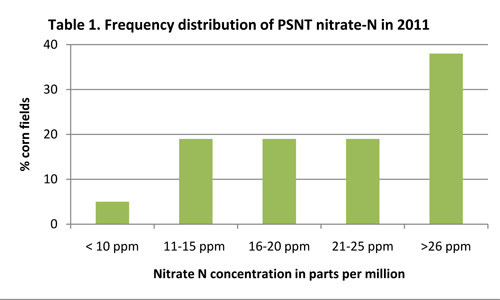Soil nitrate-N variability on corn fields with high mineralization potential
A summary of the 2011 soil nitrate test results shows that despite conditions favoring high N losses, the PSNT was a useful nitrogen management tool on fields with previous manure practices.
The distribution of soil nitrate-N concentrations as demonstrated by 2011 Pre-sidedress Soil Nitrate Test (PSNT) on 21 corn fields, each with a history of manure practices, is shown in Table 1. A high level of mineralized N was expected on these fields. The observed variability in nitrate N was a reflection of the diversity in type, amount and frequencies of manure applied, and site-specific soil and climatic factors influencing N mineralization and environmental losses.

Ten mid-Michigan corn producers participated in the 2011 study. Please refer to the highlighted articles listed below for the PSNT guidelines.
Producers used the PSNT data as a guide to determine N sidedress rates. Thirty-eight percent of fields exceeded the critical nitrate N level of greater than 25 ppm, thus requiring no additional N fertilizer and generating considerable cost savings. Two corn fields in this group were certified “organic,” receiving most of the N from dairy manure. Fifty-seven percent received varying amounts of N credit, based on the Maximum Return to Nitrogen (MRTN) recommendations approach. A very low percentage of fields (5 percent) recorded 10 or less ppm nitrate N and therefore received no N credit. The ammonium N levels were also measured, but not reported here because of their relatively low concentrations in all samples.
The spring weather conditions favored high N losses by leaching and denitrification and generated uncertainties about soil N availability. Even though the year was plagued by planting delays and shifts to shorter maturing hybrids, the 2011 data demonstrated the usefulness of PSNT for optimizing N management. It is conceivable that some soluble N was lost to early season rainfall, but organic matter mineralization was capable of generating significant quantities of available N as observed in this study.
In response to challenges encountered this year, it was encouraging to see an increased numbers of private soil testing service providers and consultants relying on soil nitrate testing.
Reductions on N fertilizer achieved as a result of 2011 PSNT will be summarized for the I Know MI Numbers Water Quality Target Program.
Related articles:
- Prep work for PSNT, George Silva, MSU Extension.
- Initial PSNT results demonstrate nitrogen credit for corn, George Silva, Jon Dahl and Natalie Rector, MSU Extension.



 Print
Print Email
Email


